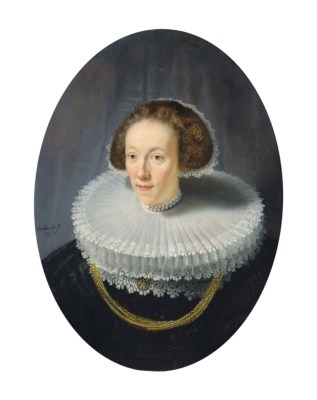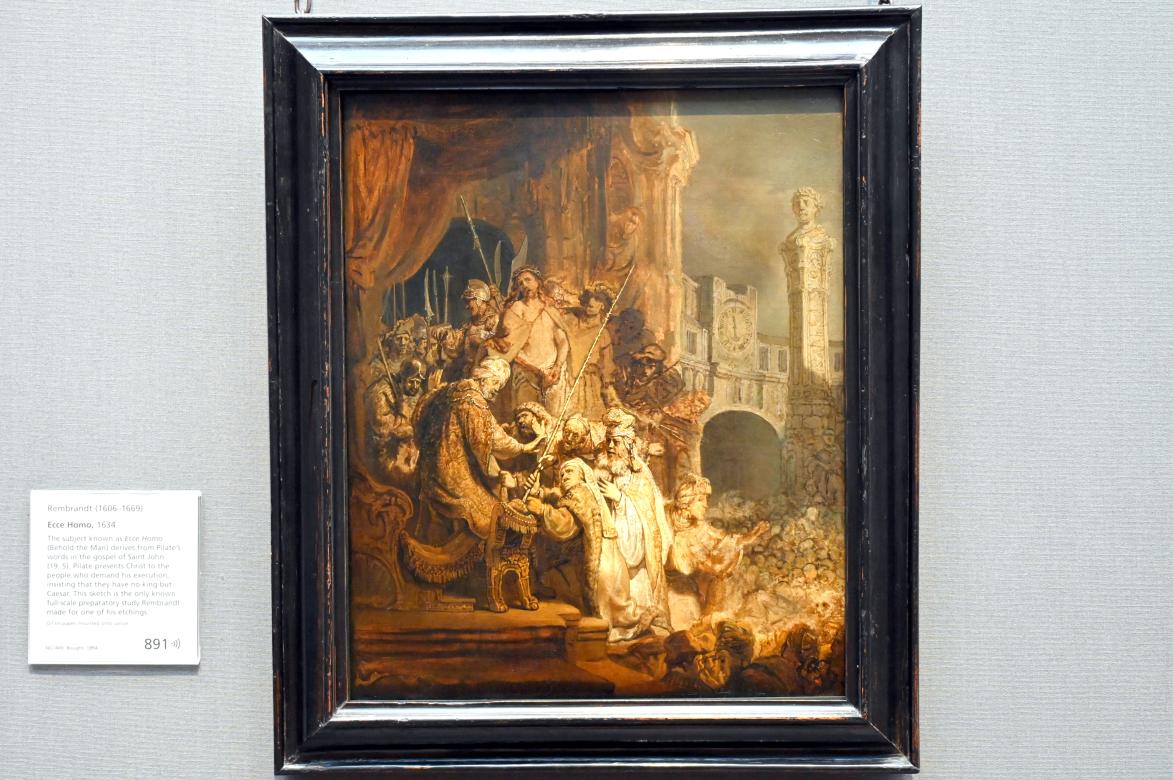Also see Rembrandt at Auction
Sotheby’s has announced that an extraordinary and rare biblical scene by Dutch Golden Age master Rembrandt van Rijn will be a highlight of itsannual New York Masters Week sale series in January 2021.
Measuring just 6 ½ by 8 ⅜ inches (16 x 21cm), Abraham and the Angels is a profoundly beautiful, gem-like painting on panel from 1646 that stands among the finest works by Rembrandt ever to come to auction. The painting last appeared at auction in London in 1848, when it sold for £64, and returns to the block this January with an estimate of $20/30 million. The work was recently the principal subject of an exhibition at the Frick Museum in New York in 2017 dedicated to Rembrandt’s depictions of Abraham from the Book of Genesis.
Of the total 136 biblical paintings Rembrandt produced, the present work is one of only five remaining in private hands, with the large majority in prominent museum collections. Among these biblical paintings, only 29 depict Old Testament scenes, with the present panel representing one of only two examples in private hands – the other being a portrait of King Uzziah stricken with Leprosy, which resides in the Devonshire Collection at Chatsworth House. As such, Sotheby’s January auction of Abraham and the Angels marks an exceedingly rare opportunity for collectors to acquire a masterpiece of this important subject by the artist.

Just this summer, Sotheby’s achieved a new auction record for a self-portrait by Rembrandt when Self-portrait of the artist sold for $18.7 million in our London sale Rembrandt to Richter (July 2020). In December 2018, the Louvre Abu Dhabi acquired the artist’s work Head of a young man, with clasped hands: Study of the figure of Christ from a Sotheby’s London auction for $12.1 million. The work, which was identified as a Rembrandt in the 1930s, belongs to a series of oil sketches referred to as his “Face of Jesus” group. Prior to that sale, the last biblical scene to appear at auction was Saint James the Greater from 1661, which sold for $25.8 million at Sotheby’s New York in 2007.
"We are honored to be entrusted with this exceptionally beautiful image from one of Rembrandt’s celebrated Old Testament scenes. The subject of Abraham visited by three angels proved a fruitful source for etchings and engravings, but this was Rembrandt’s only painting of the story. Painted in the 1640s, when the artist was moving into a more thoughtful and deeply emotional period of his career, this gem-like panel is an outstanding example of the artist’s ability to depict a complex and moving composition on a small scale. With the vast majority of his biblical scenes in institutional collections, it is extremely rare to see such a major work at auction – with this one making its last appearance nearly 175 years ago. Outside of its rarity and condition, which is pristine, it is among the very few works by the artist whose authorship has never been questioned and is an indisputable masterpiece by the artist.”
While Rembrandt is largely known for his portraiture, these works were just one aspect of his artistic expression. It is, arguably, in his historical scenes – comprising mythological, biblical and allegorical scenes, in addition to landscapes – where he found the freedom to express himself, and to experiment more freely. Painted in 1646, during an emotionally-turbulent yet highly productive period of his life, Abraham and the Angels depicts the precise moment when God, the principal source of light in the scene, reveals to Abraham that his elderly wife Sarah will bear him a son, Isaac, within a year. We can almost make out the smile on the disbelieving Sarah’s face, as she leans out of the door to their house and overhears the proclamation of the Lord.
As is typical of the artist's work of the 1640s, in which he moved away from the highly Baroque concept of capturing the most dramatic instance of a story, in favor of a more subtle rendering worthy of thoughtful observation, Rembrandt chose to illustrate the most emotionally poignant moment of the story – conveyed solely by light and a single, gently raised hand.
In addition to being one of the most well-documented paintings by Rembrandt in existence, this work also boasts an impeccable provenance, nearly unbroken from the year after its execution to the present day. Traceable to a transaction in Amsterdam in 1647 between Martin van den Broeck and Andries Ackersloot, the picture has passed through the collections of a number of notable figures including: Rembrandt’s former pupil Ferdinand Bol; 17th century merchant and Amsterdam mayor Jan Six; and with the American expatriate painter Benjamin West. After passing through several other hands, including the important collection of Sir Thomas Baring in the mid-19th century, the work entered the celebrated Pannwitz Collection in Heemstede, later to be folded into the Aurora Trust – where it had remained with the Pannwitz family for at least 90 years. The painting has remained in the same collection since it was last sold privately in 2005.
The work has been publicly exhibited only a handful of times over the years, recently appearing in Rembrandt’s Journey: Painter, Draftsman, Etcher at the Museum of Fine Arts, Boston & The Art Institute of Chicago in 2004, at the Gemäldegalerie in Berlin in 2006, and most recently as the subject of the Divine Encounter: Rembrandt’s Abraham and the Angels at the Frick Museum in New York City in 2017.
Christie’s Old Masters December 7, 2017
Christie’s Old Master s Evening Sale on 5 July 2018
Christ Presented to The People (‘Ecce Homo’) is considered to be among Rembrandt Harmensz. van Rijn’s (1606 - 1669) most significant achievements in any medium (estimate on request : in the region of $3 - 5million ) . One of the world’s most versatile, innovative, and influential artists, Rembrandt is viewed by many as the greatest printmaker of any generation . Epitomizing an artist at the height of his powers, both artistically and technically, this extr aordinary drypoint of 1655 dates from his t hird decade as a printmaker . Executed on a monumental scale, t he present work is one of only eight known impressions of the celebrated first state of this print and is the last known example in private hands . The other seven known impressions of this state are in major museum collections : Kupferstichkabinett der Staatliche Museen zu Berlin, The British Museum, The Metropolitan Museum of Art, The Ashmolean Museum, Bibliothèque Nationale de France, Musée du Louvre (R othschild Collection) and the Graphische Sammlung Albertina. Offered from The Collection of the l ate Samuel Josefowitz , it is on public view at Christie’s New York until 5 May ; going on view in Hong Kong from 24 to 28 May and then in London from 15 to 28 June and 30 June to 5 July , ahead of being offered for sale during Christie’s Classic Week in London, in the Old Master s Evening Sale on 5 July .
A masterful work, Christ Presented to The People (‘Ecce Homo’) is an extremely ambitious work, in technique, material and scale. The exceptional quality of this impression highlights Rembrandt ’s sophisticated command of drypoint, a technique which uses a sharp needle to scratch the design onto a copper plate. The rich, velvety line it creates is particularly expressive, but few really fine impressions are possible since printing flattens the tiny shards of copper (known as ‘burr’) which hold the ink.
Impressions on exotic papers were highly prized by collectors for their rarity, and by artist s for the way they held the ink; in this work Rembrandt used oriental paper, imported from Japan at great exp ense by the East India Company.
Global interest in the leading Old Masters continues to grow and Christie’s is proud to bring this magnificent drypoint to the open market at such an auspicious tim e. Christie’s is the market leader for works by the artist, having set the world record price at auction for Rembrandt when the oil

Portrait of a man with arms akimbo sold for £20.2 million in 2009.

%2C_1634%2C_National_Gallery%2C_London.jpg)
